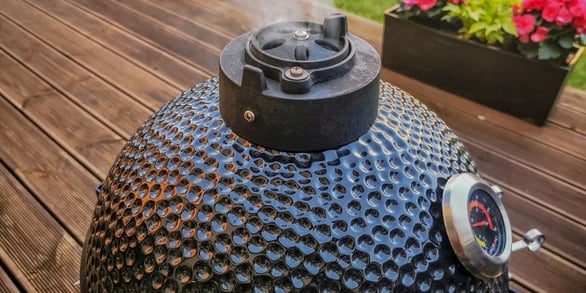 If you've ever seen a ceramic grill, then you've seen a kamado grill. There are different varieties and brands of kamado grills, but they all share one basic characteristic: They get really, really hot.
If you've ever seen a ceramic grill, then you've seen a kamado grill. There are different varieties and brands of kamado grills, but they all share one basic characteristic: They get really, really hot.
Let's take a closer look at kamados so you can better understand what using one of these ceramic grills is actually like.
Kamado Grill Design
By design, kamado grills work more like a smoker or an oven than a grill. That's because they're extremely well insulated with thick ceramic sides. When the lid of a kamado is closed, the heat is trapped inside almost like a pressure cooker.
Their seemingly modern appearance actually dates back about 3,000 years to the style of the cooking urns used in Japan. Most kamado grills are made with ceramic, but they can feasibly be created with terra cotta, cement, lava rock, and other heat-resistant materials.
Cooking with a Kamado Grill
Kamado Grills are built for maintaining heat, and while they are fueled by charcoal, they don't require much charcoal in order to cook your food. They also use minimal oxygen during the cooking process. They trap heat and oxygen beneath a dome-shaped lid and offer only a small damper for oxygen to escape. This enclosed cooking environment is ideal for keeping meat from drying out during the cooking process because the less airflow there is, the more tender your steak will be.
If you're interested in two-zone cooking, make sure you choose a style of kamado that has that capability. Some do and some don't. This is one reason many homeowners decide to have a kamado and a traditional grill in their outdoor kitchen. You may choose to use the kamado for specific items that you're smoking or baking while relying on the traditional grill for sizzling meats and other sides in a more controlled environment.
The Lifespan and Limitations of Kamado Grills
Kamado grills typically last longer than traditional charcoal grills or gas grills. Their old world design is somewhat timeless when it comes to style as well as the period of time you can expect to use them.
As we mentioned previously, kamado grills get extremely hot and take a long time to cool down. They're also very heavy. These two characteristics combined make them less than ideal for transporting to and from tailgates or other outdoor cooking events.
Anyone who owns a kamado should know what a flashover is. Due to a kamado's nearly airtight design, flashovers are a natural risk. When does a flashover occur? Typically, it's when the kamado has been shut down or left on low heat, During this time, the coals become starved for oxygen, and the moment the kamado's lid is opened and air rushes in, a fireball explodes from the grill. If this sounds serious, that's because it is.
The best way to prevent a flashover is to open the top damper on the lid and wait before opening. When you do open the lid, wear fire-resistant gloves and stand to the side in case a flashover occurs.
If you have questions on how to use a kamado grill or how to design your outdoor kitchen around one, contact us today! We'd love to help!

